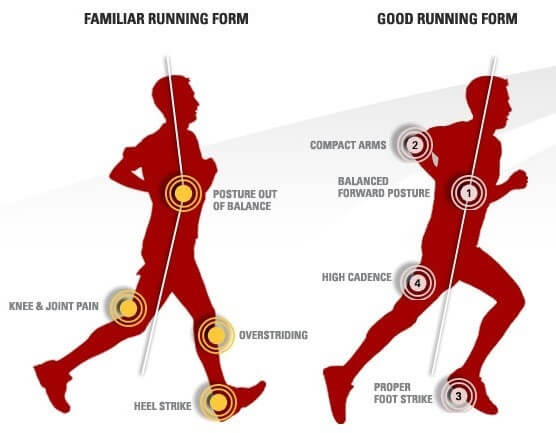Running Cadence: Good Cadence & How To Achieve It

Running cadence, or leg turnover, is defined as “the total number of ‘revolutions per minute (RPM), or the number of full cycles taken within a minute, by the pair of feet.”
You don’t have to be running for very long when you start to hear conversations about cadence. What is your cadence? What have you done to improve it? Should you worry about it?
All of these are excellent questions. And as always, when you have questions, we have answers!
Running Cadence Definition
Running cadence, or leg turnover, is defined as “the total number of ‘revolutions per minute (RPM), or number of full cycles taken within a minute, by the pair of feet.”
Measured by the number of times that your feet strike the ground per minute while running (ground contact time), cadence is usually calculated by counting the number of times that your one foot strikes the ground per minute, multiplied by two.
Is Cadence Important?
I get it. It seems kind of arbitrary, doesn’t it? I mean, taking the time to count how many times your feet hit the ground in a minute seems kind of silly when you first mention it. So why is it important?
The longer stride you take equals a lower running cadence. This is a problem because the runner has to extend their leg out in front of the body. This has a breaking effect. Not only does this slow the runner down, but it can also lead to running injury.
A higher cadence, on the other hand, generally helps a runner to hit the ground mid-foot. This, in turn, decreases the stress on the skeletal system. Putting less stress on the runner’s knees, hips, and lower back also decreases the risk of injury.
What is a Good Cadence for a Run?
Your elite runners typically run with a cadence of about 180. What an aspiration to shoot for. Not everyone can manage this type of high cadence, however. Many factors figure into what optimal cadence you can reach.
Are you now wondering what factors influence your ideal cadence?
There are five main factors:
- Height
- Weight
- Leg length
- Stride length
- Running technique
What is a Good Cadence for a Beginner Runner?
As a running coach, this is another question I am often asked. Honestly, in my 25+ years of coaching experience, I don’t find that there is a normal cadence for beginners. Most adult runners seem to fall in that sweet spot between 160 – 175, including beginners.
In the beginning, some runners tend to shuffle. This is because as you are just getting started, you have to learn to lift your feet up, even when you are tired. Once you get your cardiovascular system into good shape, the rest will fall into place.

The best advice I can give you is not to worry too much about cadence, stride rate, step rate, or any of those things while building up your fitness.
Those first 4 – 8 weeks, just focus on getting out the door and running 3-4 days each week.
What is an Average Runner’s Cadence?
The cadence average for recreational runners is about 155. That means if you are looking for a “good” cadence, you are hoping to fall somewhere between 155 and 180.
It seems reasonable, doesn’t it?
Can I Increase My Cadence?
Now that you know what running cadence is and why it’s important – is there a way to improve yours? There certainly is.
Keep in mind that although re-learning cadence is relatively easy for most people, it does take time.
Training your legs to run with a faster turnover certainly won’t happen overnight. In fact, we recommend giving yourself at least 6 to 8 weeks to adapt to running at a faster cadence.
Pushing the pace might just do more harm than good.
How Can I Increase My Cadence?
So, where do you start? First of all, measure where you’re at. After a proper warm-up, run at your normal cadence and simply count every step on your right foot for exactly one minute. Multiply this figure by two, and you have your training cadence.
And once you know where you’re at, it may be a good idea to dig up that dusty old metronome or a running watch with a metronome. A treadmill and a metronome can be invaluable in helping you re-learn an optimal cadence.
Simply set the metronome to between 160 and 170 beats or clicks per minute, and practice running to the rhythm. Or, if the thought of being trapped indoors with a metronome and treadmill makes you wince, download a metronome MP3 set to 170 beats per minute (bpm) or a playlist of songs at the same tempo.
Then simply lace up, switch on, and run to the beat. Just remember to stay safe and be aware of your surroundings.
Another method of increasing cadence is to try barefoot running. Did you know that the average cadence of barefoot runners is higher than other runners?
Running downhill is a method some people try to get a faster turnover. Running down forces you to have a quick turnover. Just be careful not to lose control. The last thing you want to happen as you work hard to improve your running is an injury.
When I coached high school track, we used to use running bungees to help runners feel fast turnover.
Believe it or not, you just bungee two athletes together with a very long piece of elastic. The first runner takes off, and the second stands still while the elastic grows taut.
When it is pulled to capacity, the second runner takes off. You have no choice but to move fast to keep up. The problem with this practice is sometimes the elastic broke, and you got snapped by the world’s biggest rubber band!
Running Cadence Chart
| Percentile in Zone | Cadence Range |
|---|---|
| >95 | >183 spm |
| 70-95 | 174-183 spm |
| 30-69 | 164-173 spm |
| 5-29 | 153-163 spm |
| <5 | <153 spm |
Source: rhoderunner.com
As you can see by the above cadence chart, one interesting thing about cadence is that it can (and usually will) vary over a run. If you think of it regarding heart rate zone training, your cadence is typically not high until you are in the higher zones of training.
For this reason, you should be focusing on your average cadence done during the meat of the workout. Focus on that period, not the warm-up, cool down, or any recovery increments of time.
The Takeaway
So if your runs feel heavy and you can’t help but envy those runners who appear to be effortlessly floating on air and having an easy run every time, try working on your running cadence. Taking the time and putting in the effort may be more than worth your while.
In addition to improving your running form and getting rid of that “heavy” feeling for good, you might just decrease your chance for injury too. What are you waiting for?
Latest Articles
 Is Running on a Treadmill Easier Than Running Outside?Runners have their own preferences, whether it is treadmill running, running outside on the road, or exploring trails. So...
Is Running on a Treadmill Easier Than Running Outside?Runners have their own preferences, whether it is treadmill running, running outside on the road, or exploring trails. So... Is It OK to Use Trail Running Shoes on the Road?While trail running shoes can be used on roads, especially in situations where a runner encounters mixed terrains or pref...
Is It OK to Use Trail Running Shoes on the Road?While trail running shoes can be used on roads, especially in situations where a runner encounters mixed terrains or pref... How to Fix Sore Quads After Running?Rest, ice, gentle stretching, and over-the-counter pain relievers can help soothe sore quads after running. Also, ensure ...
How to Fix Sore Quads After Running?Rest, ice, gentle stretching, and over-the-counter pain relievers can help soothe sore quads after running. Also, ensure ... 10 Fruits With The Most Electrolytes to Replace Sports DrinksThese fruits are high in electrolytes such as potassium, magnesium, and calcium, essential for hydration, muscle function...
10 Fruits With The Most Electrolytes to Replace Sports DrinksThese fruits are high in electrolytes such as potassium, magnesium, and calcium, essential for hydration, muscle function...

